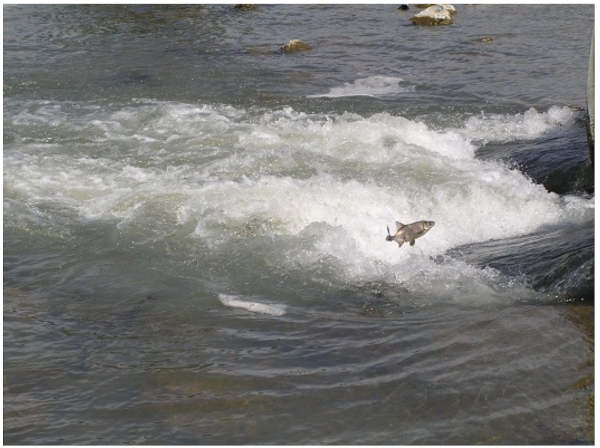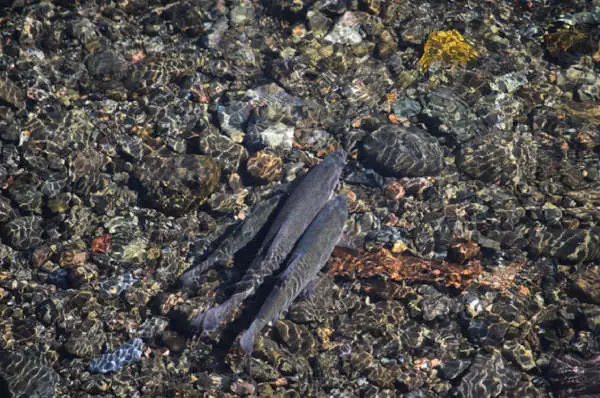Dear Lady of the Lake,
How are the Clear Lake Hitch doing? I saw that they did not get Federal Endangered Species Act (ESA) Protection? What does that mean for the future of the fish? Thanks for your column.
— Hans asking how are the Hitch —
Hi Hans!
I have been holding on to your question for a while, sorry it took so long to get to you. But this is a great time to talk about the Clear Lake hitch. The scientific name of the Clear Lake hitch is Lavinia exilicauda chi, and the native indegenous peoples of Clear Lake (the Hinthil, Gowk Xabatin, or the Pomo) refer to the fish as “chi” (pronounced CH-eye). In this article I will use hitch and chi interchangeably, as they are commonly recognized under both names.
The chi is a very culturally important fish to the Pomo, serving as a main food staple, providing a vital source of protein and nutrients, and easy to catch as the hitch prefers shallow, warm, and slow-moving water, ideal to the shores and sloughs along the edges of Clear Lake. Chi love to inhabitat shallow waters full of submergent and emergent aquatic plants, in areas with sandy or gravel bottoms. Here is where they feed on aquatic insects and terrestrial insects that rest on the surface of the water, as well as crustaceans.
Chi don’t live that long, about five to six years, and become reproductively active in their second year for females and first year for males. The maximum size for the minnow has been recorded at 350 mm (or about 13 inches). The juvenile chi are small, and easy food prey for larger game fish in Clear Lake. Juveniles mostly stay within the shallow shorelines of the lake and sloughs, in areas hard to access by their predators yet where their food is plentiful. Luckily, chi can withstand rather warm temperatures, up to 30oC (86 degrees Fahrenheit) and more, which is an advantage when they are trying to avoid predatory fish who prefer cooler waters.
Chi will spawn in the shallow yet flowing tributaries that flow into Clear Lake, usually in the springtime, but they have been observed spawning anywhere between February and July, if the weather conditions are right and there is plentiful, warm, yet well-oxygenated water in the streams. Chi will swim against currents and flows, and jump small barriers to get up stream to preferred spawning grounds. However, chi are no salmon, they are small-bodied and have limits to the heights and velocities they can overcome when swimming in a high-flowing stream.

Clear Lake chi populations and abundances have declined in recent years, with declines being noted by local residents, tribes, and the California Department of Fish and Wildlife in 2014. Since then population estimates and catch counts, conducted by several state and federal agencies, have fluctuated, but in the last four years, sharp declines and little to no recruitment of juvenile chi has raised some high concerns for this endemic, special minnow fish.
This chi is currently threatened under the California Endangered Species Act, or CESA, but failed to make the U.S. Endangered Species Act list in 2020 when it was petitioned.
You can read about this decision in the Lake County News article from Dec 3, 2020 “U.S. Fish and Wildlife Service decides against listing hitch under Endangered Species Act.”
Listing of the species adds extra protections that go into effect when the species population or habitat could be harmed or jeopardized. For example, when getting a permit to build something on the lakeshore, like a structure that goes out into the water and might disturb the shallow habitat of the lake, there are seasonal limitations of the year when that building is prohibited; this is a state CESA protection to prevent habitat loss or injury to the Hitch or direct loss of the Hitch themselves.
The story of the chi is complicated, and the chapters to recovery are even more so. There is still so much unknown information about the chi, particularly that time in the streams after they spawn when the eggs hatch and the fingerlings, then juveniles, make their way downstream to the Lake. Fish biologists and water resource managers don’t know what happens to the chi during this time and we don’t know factors are causing the chi numbers to be so low. Drought and surface / and subsurface water use are most certainly having impacts, but the specific mechanisms of how are currently unknown.
Spawning observations in the creeks is high; we can see them spawning and we can count high numbers. After that, something is happening to the eggs or baby chi that is causing them not to become adults in the lake, or hindering their ability to make more baby chi.

Some of this important research is being led by research fish biologists from the United States Geological Survey, or USGS, California Water Science Center in Sacramento, California. Research conducted in the lake from the last five years has demonstrated drastic declines in young Hitch in Clear Lake. Those biologists are going to investigate post-spawning activities, and sample streams during and after spawn, to identify what exactly is happening to hitch in the streams and what management actions would be best suited to aid in recovery of the species.
However, before significant and expensive actions and restoration projects can take place, fish biologists and agency scientists need to have a clear plan. Over the last couple years, there has been a huge, collaborative effort to establish a plan for recovery, called The Hitch Conservation Strategy.
The strategy plan is being coordinated by the US Fish and Wildlife Service, or USFWS, but includes many local partners such as those from regional tribes like Big Valley Rancheria, Middletown Rancheria, and Robinson Rancheria, County of Lake, the Lake County Land Trust, private citizens, CDFW, and more. This plan is hefty, and again, relies on information that is yet unknown.
How can you help?
There are several ways you can help.
First, educate yourself about the Hitch and about lake and stream ecology and biology. Luckily, by reading the Lady of the Lake columns and asking important questions, like you did Hans, you are already accomplishing this step. If everyone understands the ecology and biology of this important species, and it’s habitat, the community as a whole will appreciate and value this species, and be aware of the kinds of activities that have negative impacts on the fish and their habitat.
An easy way to learn a great deal about the Clear Lake kitch is to check out the video below, from a public forum called Water Quality Wednesday that was held on Jan. 12 and hosted by Lake County Water Resources.
This video is about an hour long, but broken up into two 20-minute presentations. Moderated by myself, the Lady of the Lake, the first presentation is by a research biologist from USGS, Dr. Fred Feyrer, and he discusses his recent observations and data on Hitch from Clear Lake.
The second presentation is by Amber Aguilera, a scientist of the US Fish and Wildlife Service, and she goes through the current outline of the draft conservation strategy, and the actions and management being proposed to help in the recovery of the hitch and its habitat.
The second way you can help is to volunteer a few hours during the spring (March, April or May) to help do hitch observations and counts.
It’s really very easy. This is a great activity for extra credit for a science or environmental class, a great activity for girl or boy scouts, or just a great way to get outdoors and spend some time with family or friends. All while giving back to a special species that really needs all our help!
There are several ways you can participate in this important effort:
You can download volunteer directions and datasheets from the Chi Council website from the tab on the left. Basically, it includes driving around to bridges and public access points of spawning creeks (like Clover, Middle, Scotts, Adobe/Highlands, Manning and Kelsey) and wait till you spot a hitch. If you go during the right time of year, you won’t have to wait long! Take a few moments and see how many you see and can count. Note any spawning behavior. Review the full protocols provided by the Chi Council before starting any Hitch counts.
You can record locations on the map online provided by the Clear Lake Environmental Research Center, or CLERC, in their Hitch Observation Program. CLERC also has lots of videos of hitch to show you what you are looking for and how to identify the hitch (don’t get them confused with carp!). CLERC also has forms and directions you can view, download, or print to help you.
Lastly, you can call the County of Lake Water Resources Department at 707-263-2344 to get paper forms and directions for doing Hitch observations, and recommendations on busy spots.
For teachers and troop leaders: If your classroom, study group, girl/boy scout troop wants to learn how to observe and track hitch, and you want a Water Resources staff to lead, guide, or assist you, call Water Resources or email them, and might be able to help you or connect you with someone who can guide your group.
Thanks for your questions Hans, and thanks for caring about the Clear Lake hitch. The recovery of this unique species will be slow, but together, with dedicated and caring community-members like you, the Clear Lake hitch has a bright future.
If you have more questions about the Clear Lake hitch, I suggest you watch this informative video all about the hitch. If you still have questions or comments, you can direct them to the Lake County Water Resources Department, 707-263-2344, or through email at This email address is being protected from spambots. You need JavaScript enabled to view it. and they can help answer your questions or get you in touch with someone who can.
Sincerely,
Lady of the Lake
Angela De Palma-Dow is a limnologist (limnology = study of fresh inland waters) who lives and works in Lake County. Born in Northern California, she has a Master of Science from Michigan State University. She is a Certified Lake Manager from the North American Lake Management Society, or NALMS, and she is the current president/chair of the California chapter of the Society for Freshwater Science. She can be reached at This email address is being protected from spambots. You need JavaScript enabled to view it..

 How to resolve AdBlock issue?
How to resolve AdBlock issue? 





